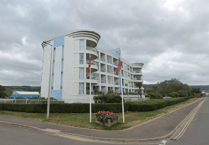But since the doors of the lifeboat station finally closed almost 80 years ago and rescue operations were transferred to Minehead, there has been nothing to commemorate the often heroic feats of the men who went out in all weathers under sail and oar, to save lives at sea.
Now there are growing hopes that this omission could be remedied. The Esplanade building, which is now a library, has been barcoded under the QR system, which enables smart-phone owners to learn about its history.
And local boat-owners and conservationists are seeking support for a commemorative plaque on the building.
Said a spokesman for Watchet Boat Owners’ Association: “The WBOA was started by sailors and fishermen to raise funds for the lifeboat. We would welcome anything that recognises that the lifeboat was an important part of the town’s history.”
Watchet’s first lifeboat arrived in the town in 1875, and the last, the Sarah Pilkington - one of the few remaining rowing and sailing lifeboats - left in 1944.
In fact, Watchet nearly lost its lifeboat in 1900 when the RNLI opened its new water-side station at Minehead. The Watchet lifeboat needed at least 20 people to haul it on its carriage along the Esplanade onto the town slipway, where it could be launched on a high tide.
However, should the tide be out, the boat was dragged across the mud through the harbour entrance and across rocky ground to the sea by up to eight horses before launching into often violent wind and waves.
Watchet was outraged by the RNLI decision to remove its lifeboat and a meeting of residents claimed that Watchet had a bigger and better lifeboat crew and was better placed for rescues.
Not only was the appeal successful, but it resulted in a brand-new lifeboat, the John Linguard Ross, which was ceremoniously launched in 1903 by Lady Acland Hood.
There had been a similar ceremony 28 years earlier when another local dignitary, Mrs Joseph Somes, named Watchet’s first lifeboat after her late husband.
The 30ft Joseph Somes was soon in action when the Gloucester trow Rose dragged her anchor off Watchet in a north easterly gale and ended up on the rocks of Warren Bay. With Captain Henry Press at the helm, the lifeboat was launched and the crew of the Rose rescued.
Hours later, the Cardiff sloop Olive Branch was also seen drifting towards the rocks. The lifeboat took off her captain and crew of two before the Olive Branch was also driven ashore and wrecked only yards from the Rose.
Another epic rescue took place on a wild November night in 1899 when the Minehead fishing boat Rosalie got into difficulties in a north-westerly gale off Watchet harbour.
Waves threatened to swamp the boat and after hours of exposure to bitter cold, fishermen John Bryant and George Wills were helpless to reach safety without assistance and the lifeboat WHG Kingston was launched after being manhandled through the mud.
Once outside the harbour it was obvious that the rowing lifeboat couldn’t stem the tide and was swept up-channel away from the boat in distress.
Willie Lee, a reporter on the West Somerset Free Press, watched the drama and in a special supplement of the paper gave a breathless account of what happened.
“An hour passes with no sign of the lifeboat. Meanwhile, the despairing cries of the men in jeopardy continue. A suggestion is made that a smaller lighter boat might be able to reach the fishing boat whereas the heavier lifeboat has failed.”
“Five local skippers, Captains William Escott, Alfred Wedlake, James Davies and Alfred and Simon Nicholas, all lifeboat volunteers, decide to row out in a small boat in an attempt to reach the stricken Rosalie.”
As Willie Lee described it: “Captain Escott takes charge and amid tumultuous cheering, the brave fellows are off. For a moment the elements seem determined to check them but they safely emerge through the broken water and pull away. Amid a torrent of cheering, the boat returns with the fishermen who are landed amid scenes of tremendous enthusiasm and are quickly borne off to Mrs Lee’s Refreshment Rooms where restoratives and everything necessary are found for the men.
“Bryant quickly recovers, but Willis is not so fortunate and it takes a good deal of work on the part of several willing helpers to restore animation to his body and limbs which are almost ice-cold.”
After the departure of the Sarah Pilkington no-one quite knew what to do with the lifeboat house until Leonard Laity Stoate, whose family had been flour millers in Watchet, bought the building in 1951 and gave it to the town as a library.
Now it’s hoped that before too long it will also be the place where Watchet’s forgotten heroes are once again remembered.




